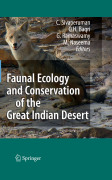
Faunal Ecology and Conservation of the Great Indian Desert
Sivaperuman, C.
Baqri, Q.
Ramaswamy, G.
Naseema, M.
The Great Indian or Thar Desert is characterized by extremely harsh climatic conditions. Nevertheless, this unique region, consisting of very different habitats ranging from grassland, sand dunes and rocky expanses to hilly wooded terrains, but also crop fields and abandoned human habitations, features a spectacular biodiversity. In 16 chapters, reputed experts in their fields describe the regional climate and microclimatic regime of this hot, arid desert, and its diverse faunal inhabitants. These range from dung beetles, ants and spiders to lizards and snakes, vultures, doves and other birds, bats, gerbils and mice, and mammals including the gazelle and langur, some appearing in the IUCN RedList of threatened species. Key aspects of the ecology and conservation of this endangered ecosystem are discussed, notably pest control and the protectiverole of local religious communities, as well as the impacts of large-scale irrigation schemes, changing land-use patterns and climate change. Provides novel information on various aspects of desert faunal ecology and conservation in the Great Indian Desert, with implications for similar ecosystems worldwide A significant contribution to the conservation of this unique ecosystem
- ISBN: 978-3-540-87408-9
- Editorial: Springer
- Encuadernacion: Cartoné
- Páginas: 220
- Fecha Publicación: 01/11/2008
- Nº Volúmenes: 1
- Idioma: Inglés
